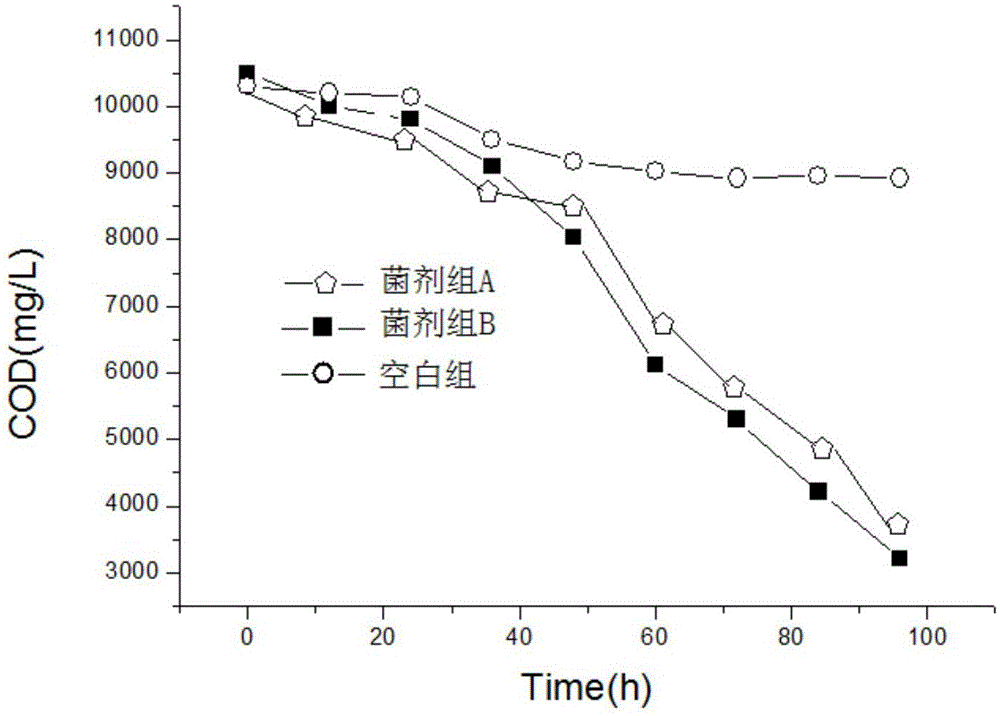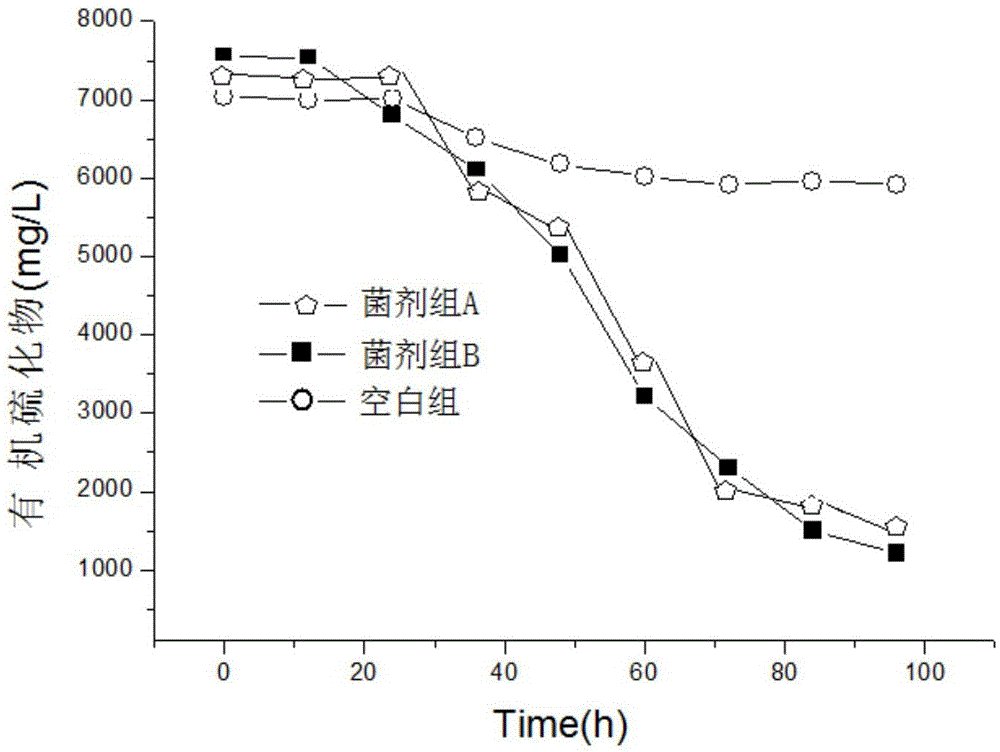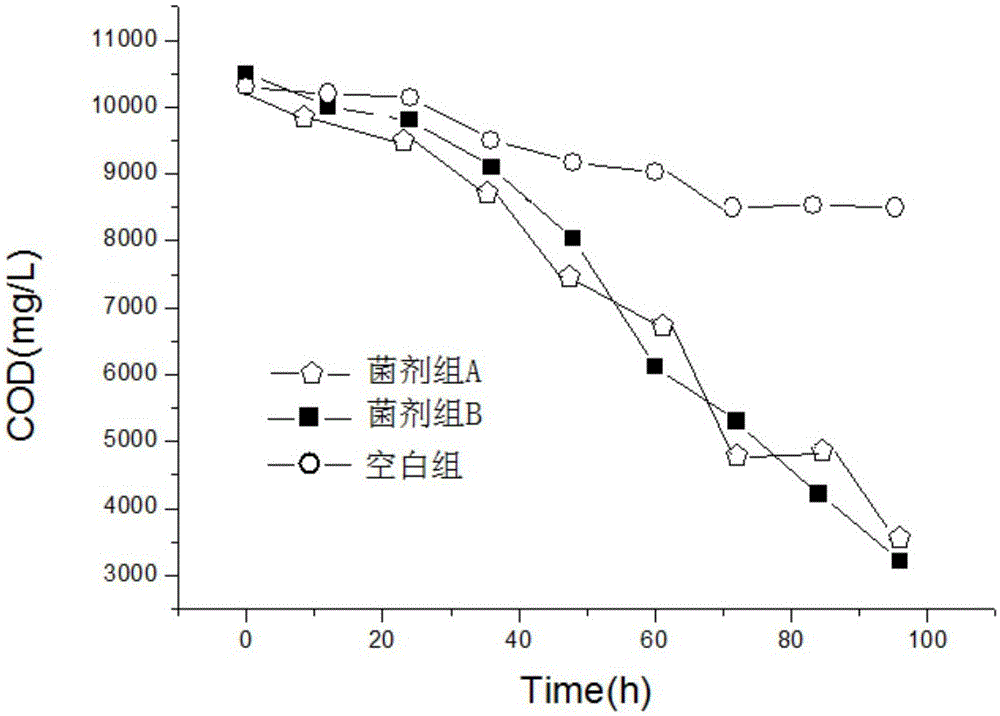Composite bacterium and application thereof to treatment of garlic processing wastewater
A technology of garlic processing wastewater and compound bacterial agent, which is applied in processing wastewater treatment, food industry wastewater treatment, biological water/sewage treatment, etc., can solve the problem of poor COD degradation ability of water body, increased water treatment cost, and reduced sludge activity, etc. problems, to achieve the effect of strengthening degradation performance and impact resistance, fast response time, and achieving standard discharge
- Summary
- Abstract
- Description
- Claims
- Application Information
AI Technical Summary
Problems solved by technology
Method used
Image
Examples
Embodiment 1
[0023] Embodiment one: the preparation of composite bacterial agent
[0024] 1. Strains
[0025] Group A strains:
[0026] Bacillus megaterium: Bacillus megaterium SWSB401
[0027] Pseudomonas stutzeri: Pseudomonas stutzeri SWSP001
[0028] Aspergillus oryzae: Aspergillus oryzae SWSA002
[0029] Klebsiella oxytoca: Klebsiella oxytoca SWSK003
[0030] Desulfovibrio desulfuricans: Desulfovibrio SWSD001
[0031] Group B strains:
[0032] Bacillus megaterium: Bacillus megaterium ATCC12872
[0033] Pseudomonas stutzeri (Pseudomonas stutzeri): Pseudomonas stutzeri ATCC17588
[0034] Aspergillus oryzae: Aspergillus oryzae ATCC 42149
[0035] Klebsiella oxytoca: Klebsiella oxytoca ATCC43086
[0036] Desulfovibrio desulfuricans: Desulfovibrio desulfuricans ATCC 27774
[0037] 2. Medium
[0038] Medium Ⅰ: 1.5g glutathione, 7g beef extract, 1g cysteine, 15g glucose, 2g KCl, (NH 4 ) 3 PO 4 ·3H 2 O 3g, K 2 SO 4 2g, MgCl 2 3g, NaCl 4g, distilled water 1000mL, and autoclave...
Embodiment 2
[0054] Embodiment two: the preparation of composite bacterial agent
[0055] Composite microbial preparation is prepared, and the same part as in Example 1 is not repeated, and the difference is that in step S6, the mixing ratio of each bacterial species component is different, specifically:
[0056] Composite bacterial agent A preparation:
[0057] Step S6, the 5 strains of the strains of group A are divided into 20% of Bacillus megaterium, 10% of Pseudomonas stutzeri, 15% of Aspergillus oryzae, 10% of Klebsiella oxytoca, 10% of desulfurization and desulfurization arc The bacterial cell percentage concentration ratio of 5% bacterial content is mixed, and the composite bacterial agent A of the present invention is obtained.
[0058] Composite bacterial agent B preparation:
[0059] Step S6, the 5 strains of the strains of group B are divided into 20% of Bacillus megaterium, 10% of Pseudomonas stutzeri, 15% of Aspergillus oryzae, 10% of Klebsiella oxytoca, 10% of desulfurizat...
Embodiment 3
[0060] Embodiment three: the preparation of composite bacterial agent
[0061] Composite microbial preparation is prepared, and the same part as in Example 1 is not repeated, and the difference is that in step S6, the mixing ratio of each bacterial species component is different, specifically:
[0062] Composite bacterial agent A preparation:
[0063] Step S6, the 5 strains of the strains of group A are divided into 30% of Bacillus megaterium, 15% of Pseudomonas stutzeri, 35% of Aspergillus oryzae, 35% of Klebsiella oxytoca, 35% of desulfurization and desulfurization arc The bacterial cell percentage concentration ratio of bacterial content of 15% is mixed to obtain the composite microbial agent A of the present invention.
[0064] Composite bacterial agent B preparation:
[0065] Step S6, the 5 strains of the strains of group B are divided into 30% of Bacillus megaterium, 15% of Pseudomonas stutzeri, 35% of Aspergillus oryzae, 35% of Klebsiella oxytoca, 35% of desulfurizati...
PUM
 Login to View More
Login to View More Abstract
Description
Claims
Application Information
 Login to View More
Login to View More - R&D
- Intellectual Property
- Life Sciences
- Materials
- Tech Scout
- Unparalleled Data Quality
- Higher Quality Content
- 60% Fewer Hallucinations
Browse by: Latest US Patents, China's latest patents, Technical Efficacy Thesaurus, Application Domain, Technology Topic, Popular Technical Reports.
© 2025 PatSnap. All rights reserved.Legal|Privacy policy|Modern Slavery Act Transparency Statement|Sitemap|About US| Contact US: help@patsnap.com



